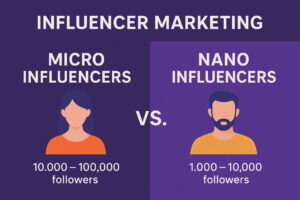Influencer marketing has become one of the most powerful strategies for brands to connect with consumers. As the digital landscape evolves, so do the types of influencers that drive results. In recent years, micro and nano influencers have emerged as key players, reshaping how brands approach partnerships. Understanding the differences between them — and how they’ll shape the future — is crucial for marketers looking to stay ahead.
Understanding Micro and Nano Influencers
Micro and nano influencers are defined by the size of their audience:
- Micro influencers typically have between 10,000 and 100,000 followers. They are often niche-focused creators who have built a dedicated and engaged audience within a specific area of interest, such as beauty, travel, fitness, or technology.
- Nano influencers generally have between 1,000 and 10,000 followers. These individuals may not be professional content creators but have developed a highly engaged community, often consisting of friends, family, and local followers.
Despite their smaller follower counts compared to celebrities or macro influencers, both micro and nano influencers bring immense value through authenticity and trust.
Why Smaller Influencers Are Gaining Traction
As consumer behavior shifts, so does the way people respond to promotional content. Today’s audiences are more skeptical of traditional advertising and celebrity endorsements. They crave authenticity, real-life experiences, and relatable voices. This is where micro and nano influencers shine.
1. Higher Engagement Rates
Nano and micro influencers often have higher engagement rates compared to influencers with larger audiences. Their followers are genuinely interested in their content, leading to more likes, comments, shares, and conversions. Studies show that nano influencers can achieve engagement rates of up to 8%, while micro influencers often hover around 3–5%.
2. Stronger Community Connections
Nano influencers typically have personal relationships with a portion of their audience. Their recommendations come across as genuine advice rather than paid promotions. Micro influencers, while more scaled, still maintain close ties with their followers and often engage in meaningful conversations.
3. Cost-Effective Collaborations
For brands, working with micro and nano influencers is more budget-friendly than investing in celebrity endorsements. This opens the door for small businesses and startups to run influencer campaigns without massive marketing budgets.
4. Niche Targeting
Micro influencers usually specialize in a specific niche, making it easier for brands to reach a targeted audience. Whether it’s organic skincare, sustainable fashion, or tech gadgets, collaborating with a micro influencer in that space ensures the message reaches the right people.

Comparing Micro and Nano Influencers
Each type of influencer brings unique strengths. Understanding their differences helps brands decide which is best for their campaign goals.
|
Criteria |
Micro Influencers | Nano Influencers |
|
Followers |
10K–100K |
1K–10K |
|
Engagement |
High |
Very High |
|
Trust Level |
Strong | Extremely Strong |
|
Cost |
Moderate |
Low |
| Reach | Wider |
Limited but focused |
| Content Style | Semi-professional |
Natural and authentic |
While micro influencers offer a balance between reach and engagement, nano influencers deliver intimacy and trust, especially for community-led or hyperlocal campaigns.
The Future Outlook
The future of influencer marketing is expected to prioritize authenticity over aesthetics and community over celebrity. Here’s how both micro and nano influencers will play a role:
Long-Term Partnerships
Brands are shifting from one-time posts to long-term relationships with influencers. Micro and nano influencers are ideal ambassadors because of their ability to consistently create relatable content and foster trust with their audience.
Local and Hyperlocal Marketing
As brands target smaller cities and specific communities, nano influencers will become key players. Their influence within their immediate circles can drive real-world action and offline conversions.
Co-Creation and Product Collaborations
Micro influencers, with their niche authority, are being brought into the product development process. Brands are increasingly co-creating limited edition products, collections, or services with them to tap into their loyal follower base.
AI-Powered Influencer Discovery
With the growth in demand for micro and nano influencers, platforms and tools powered by AI are helping brands discover these creators based on location, audience interest, and engagement metrics — making it easier to scale influencer programs.
Final Thoughts
Micro and nano influencers are not just trends; they represent a shift in how consumers engage with content and make purchase decisions. As influencer marketing continues to evolve, the focus will move away from follower count and toward trust, relatability, and niche expertise.
If you want to grow your social media presence through smart influencer marketing strategies, contact Atina Technology. We specialize in social media and Digital Marketing that helps your brand connect, engage, and convert.
Brands that embrace this shift and build genuine partnerships with smaller influencers will gain a competitive edge. Whether it’s through local community campaigns or niche product endorsements, micro and nano influencers are set to define the next chapter in influencer marketing.


